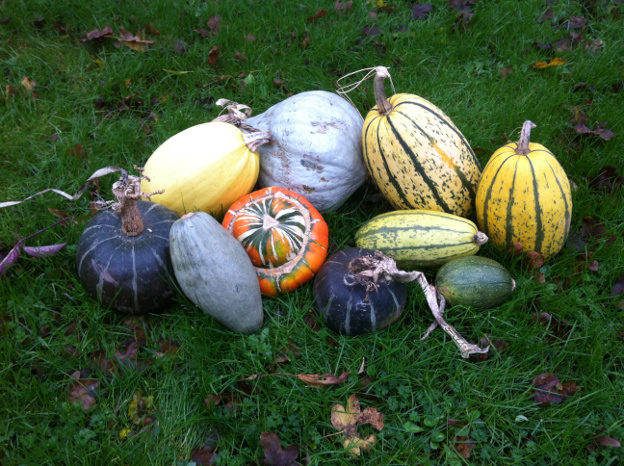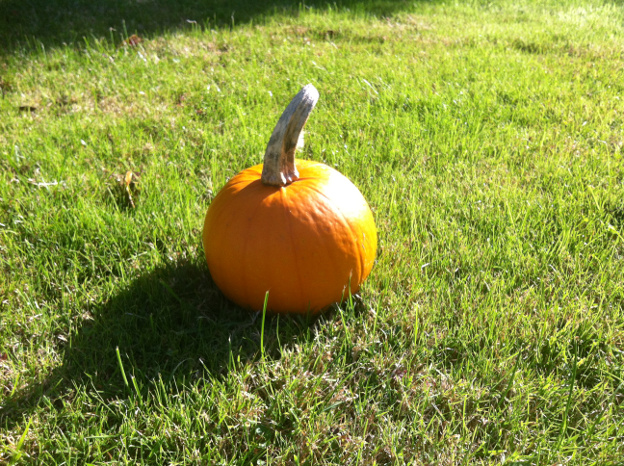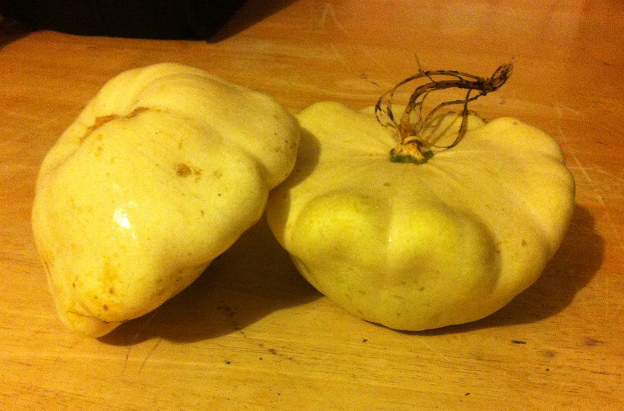With the squash growing season now well and truly over here in the East of England, we are delighted to be able to able to share some photos of our very successful 2015 squash harvest. As long time readers will know, we only moved into our house and had use of its garden from May this year. We got off to a bit of a slow start due to other demands such as unpacking, work and raising children. But once we got the time we really went for it in the garden.
One of our biggest projects was removing the turf from an area of the garden and creating our ‘pumpkin patch’. This hard work has since borne some rather beautiful and exciting fruit. I’ve already posted many times about the courgettes and tomatoes we got from this patch. Today I’m going to focus on patty pans and, most excitingly of all, the winter squashes!
Our ‘Baby Pam’ Pumpkin
First to be harvested was a pumpkin of the variety ‘Baby Pam’. This variety produces very compact plants (perfect for our patch), and yields rather small fruits. Our plant only produced one pumpkin, but that one was a fine specimen. The plant died not long after the pumpkin ripened, so we hardened it off and brought it in. The children were particularly proud of our pumpkin. We were too. There’s something special about growing a pumpkin, even a small one. The kids loved it so much that it was handled excessively and the skin received a few digs in the process. We decided that it wasn’t really fit for storage, so we used it in a vegetable curry. Delicious it was too.
Patty Pans
The next squash plant in the pumpkin patch to be harvested for its fruits was the patty pan plant. We only planted one, and it seemed very slow to get going, but it did eventually yield a few patty pans. We love patty pans. I think we prefer growing courgettes with their higher yields and more versatile cooking properties. But patty pans are rather fascinating fruits, so we wanted to set a little space aside for them. For a time it didn’t look like we were going to get anything from the plant. Much was our excitement when one evening we pulled back some of the foliage to reveal female flowers.
The Winter Squashes
As you will have seen from the photo at the top of this post, we grew a variety of winter squashes this year. I’ve posted before about how excited we were to grow winter squashes. We’d helped to grow them before at our local community garden, but we’d never actually grown our own. We’d always wanted to, but never had the space. So as soon as we moved into this house and discovered the size of the garden, the first words we exchanged were (in unison), “We can grow squashes!” Nearly seven months on and we are enjoying our homegrown squashes, with more in storage for the winter. Here are the squashes we are most excited about:
The ‘Spaghetti’ Squash
This is by far the squash we are most excited about. The flesh of this squash, when baked, apparently transforms into spaghetti-like strands that can be used as a spaghetti substitute. Back garden homegrown spaghetti – now that’s really moving into self-sufficiency territory! We’ve been longing to try this for years, but we’ve never seen one for sale anywhere. It seemed the only way we were going to be able to try this squash was grow our own. Of course we’ve never had the space before, but this year we did, and so this was first on our list of squashes to grow. Now we can finally try it. We’ll be sure to post back once we have.
The ‘Blue Hubbard’ Squash

An impressive ‘Blue Hubbard’ squash. Apparently these keep really well. I’m not sure we’ve got the will power to put that to the test though!
This was the first squash for start to form in the pumpkin patch, and it grew enormous. We were very proud of it, and its parent plant seemed to be too, because after its initial success, it didn’t seem bothered about producing any more female flowers. But as you can see from the photo, it’s quite a specimen. We’re really looking forward to this one. The variety is supposed to keep well, and it’s hardened off nicely. So we may try to resist temptation and put this one into storage. We’ll see…
Turk’s Turban Squash
This is the only winter squash that we grew that we have actually eaten before. We once bought one of these from a farm shop, and we were given an allotment-grown one on another occasion. We thoroughly enjoyed them both times, but we mainly wanted to grow them for their distinctive colours. We weren’t disappointed, as the beautiful squash in the photo demonstrates.
Final Thoughts
We’ve done a lot of things so far this year. We’ve grown a variety of crops, had some decent harvests and put most of it to good use, either at the time or preserved for later. However, without a doubt our proudest achievement is the squashes. We’ve been wanting to grow them for years. As soon as we had the opportunity, we took it and produced all of this lovely food. There was a lot of hard graft – removing the turf, digging the patch, forking the manure in. Planting the seeds and then nurturing the plants when the summer didn’t quite want to get started. The seemingly endless pacing up and down the garden laden with watering cans. But it was a resounding success. We couldn’t be happier with the results. We haven’t quite planned what to do with the pumpkin patch next year. Crop rotation dictates that our squashes will be grown elsewhere and we won’t have anything like as much space. So this will probably be our best crop for a few years. Now it’s time to enjoy them.






